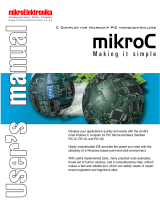
UM0402 Firmware features
15/35
Twelve pages of 64 Bytes are used for storing 456 Bytes (12x38 Bytes) of
EEPROM_month_Union structure of EEPROM_DATA_Month_Union data type.
Each page of 64 Bytes of EEPROM is separately storing 38 Bytes of data related to each
month. The information stored for each month is:
●Energy consumption during tamper;
●First and last box tamper time and date;
●First and last line tamper time and date;
●Total month tamper time;
●Total month power down time.
EEPROM_month_Union structure is stored as below:
4Dh power_down_date: Day, Month, Year volatile unsigned char
50h power_down_time: Sec, Min, Hour volatile unsigned char
53h pwr_dn_index_year volatile unsigned char
54h pwr_dn_index_mon volatile unsigned char
55h Index_Box_Tamper volatile unsigned int
57h Index_Fraud_Tamper volatile unsigned int
Table 3. EEPROM common information (for each month)
EEPROM
Address Description Data Type
80h kWh_Energy_Tamp volatile unsigned long
84h Pulse_Count_Tamp volatile unsigned int
86h First_Tamper_Time_Box : Sec, Min, Hour volatile unsigned char
89h First_Tamper_Date_Box : Day, Month, Year volatile unsigned char
8Ch Last_Tamper_Time_Box : Sec, Min, Hour volatile unsigned char
8Fh Last_Tamper_Date_Box : Day, Month, Year volatile unsigned char
92h First_Tamper_Time_Fraud : Sec, Min, Hour volatile unsigned char
95h First_Tamper_Date_Fraud : Day, Month, Year volatile unsigned char
98h Last_Tamper_Time_Fraud : Sec, Min, Hour volatile unsigned char
9Bh Last_Tamper_Date_Fraud : Day, Month, Year volatile unsigned char
9Eh Total_Tamper_Time : Sec, Min volatile unsigned char
A0h Total_Tamper_Time : Hour_Tamper_Time: Hour volatile unsigned int
A2h Power_Failure_Time: Sec, Min volatile unsigned char
A5h Power_Failure_Time: Hour_Tamper_Time: Hour volatile unsigned int
Table 2. EEPROM common information
EEPROM
Address Description Data Type




















